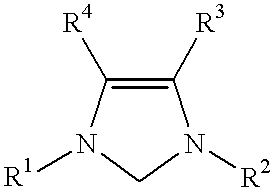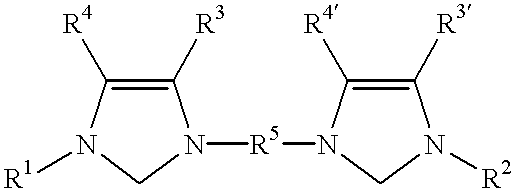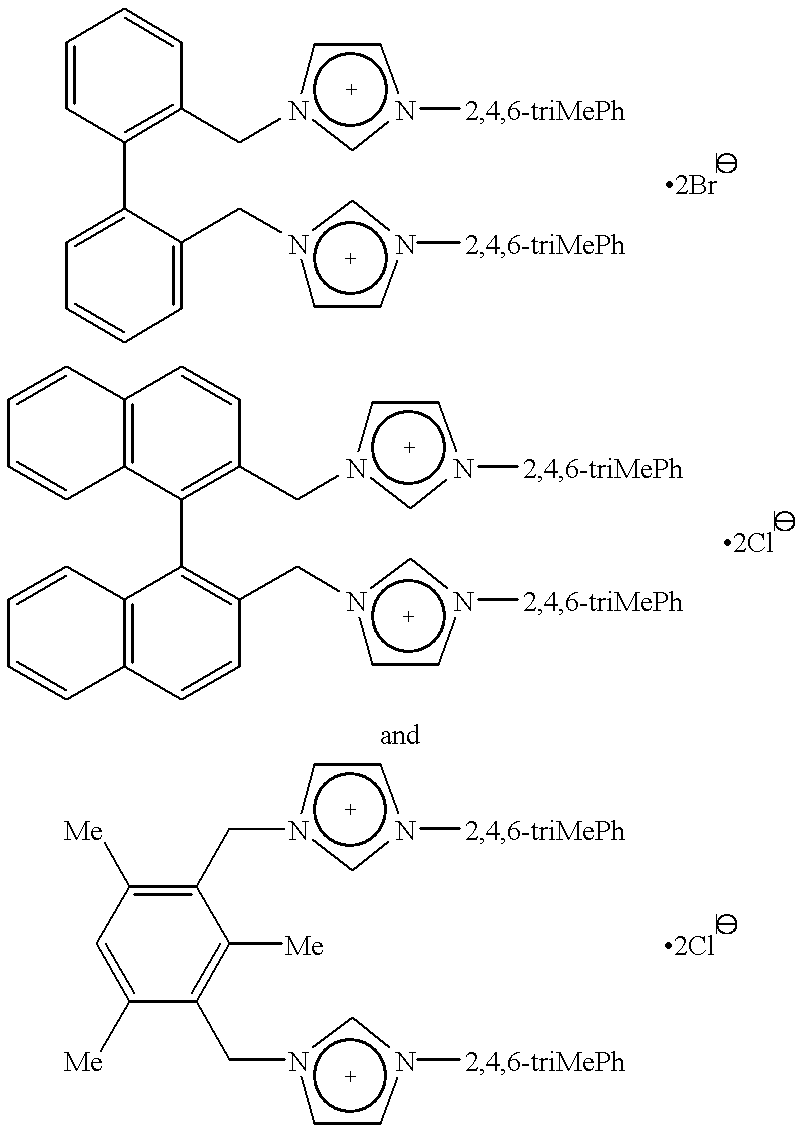Catalyst system comprising transition metal and imidazoline-2-ylidene or imidazolidine-2-ylidene
- Summary
- Abstract
- Description
- Claims
- Application Information
AI Technical Summary
Benefits of technology
Problems solved by technology
Method used
Image
Examples
example 1
2,6-Diisopropylaniline (100 g, 0.56 mol), glyoxal (31.5 mL, 40% in water, 0.28 mol), and absolute ethanol (500 mL) were charged to a round-bottom flask. A few drops of formic acid were added, and the solution immediately changed from colorless to yellow. After a few hours, a yellow precipitate appeared. The reaction mixture was stirred for another two days. The yellow precipitate was collected by filtration and washed with cold methanol. 1,4-Bis(2,6-diisopropylphenyl)diazabutadiene was obtained in the amount of 81.74 g, a yield of 77.5%.
Toluene (500 mL) and 1,4-Bis(2,6-diisopropylphenyl)diazabutadiene (25 g, 66 mol) were added to a reaction vessel, followed by solid paraformaldehyde (2.0 g, 66 mmol). The reaction mixture was heated to 100.degree. C. until most of the paraformaldehyde had dissolved. The mixture was then cooled to 40.degree. C., and HCl (16.5 mL, 4 moles per liter in dioxane, 66 mmol) was added via syringe. The reaction mixture turned brown in color, and a white preci...
example 2
Catalyzed amination reactions were carried out using several different imidazolinium-2-ylidene chlorides. For each run, a Schlenk tube was charged with Pd.sub.2 (dibenzylideneacetone).sub.3 (10 mg, 0.01 mmol), 1,3-bis(substituted)imidazolinium chloride (0.04 mmol), and a magnetic stirring bar. After a 30 minute catalyst activation period, 1,4-dioxane (3 mL), KOtBu (168 mg, 1.5 mmol), 4-chlorotoluene (1.0 mmol), and N-methylaniline (1.2 mmol) were added in turn to the Schlenk tube. The Schlenk tube was placed in a 100.degree. C. oil bath and the mixture was stirred for 3 hours. The mixture was then allowed to cool to room temperature. The mixture was washed with diethyl ether. The organic layer and the diethyl ether extracts were combined, washed with saturated saline solution, and then dried over MgSO.sub.4. The solvent was removed under vacuum and the residue was purified by flash chromatography using hexane or a mixture of hexane and ethyl acetate.
The 1,3-bis(substituted)imidazoli...
example 3
Catalyzed Kumada coupling reactions were carried out in a variety of solvents and / or solvent mixtures. For each run, a Schlenk tube was charged with Pd.sub.2 (dibenzylideneacetone).sub.3 (10 mg, 0.01 mmol), 1,3-bis(substituted)imidazolinium chloride (0.04 mmol), and a magnetic stirring bar. After a 30 minute catalyst activation period, solvent (5 mL), 4-chlorotoluene (1.0 mmol), and phenylmagnesium bromide (1.2 mmol) were added in turn to the Schlenk tube. The Schlenk tube was placed in an oil bath and the mixture was heated and stirred for a number of hours. The mixture was then allowed to cool to room temperature. The mixture was hydrolyzed either with aqueous HCl (1.0 moles per liter) or H.sub.4 NCl solution. The solvent was removed under vacuum and the residue was purified by flash chromatography using hexane or a mixture of hexane and ethyl acetate.
The 1,3-bis(substituted)imidazolinium chloride used in each run are listed in Table 2. All of the yields reported in Table 2 are of...
PUM
| Property | Measurement | Unit |
|---|---|---|
| Fraction | aaaaa | aaaaa |
| Fraction | aaaaa | aaaaa |
| Time | aaaaa | aaaaa |
Abstract
Description
Claims
Application Information
 Login to View More
Login to View More - R&D
- Intellectual Property
- Life Sciences
- Materials
- Tech Scout
- Unparalleled Data Quality
- Higher Quality Content
- 60% Fewer Hallucinations
Browse by: Latest US Patents, China's latest patents, Technical Efficacy Thesaurus, Application Domain, Technology Topic, Popular Technical Reports.
© 2025 PatSnap. All rights reserved.Legal|Privacy policy|Modern Slavery Act Transparency Statement|Sitemap|About US| Contact US: help@patsnap.com



